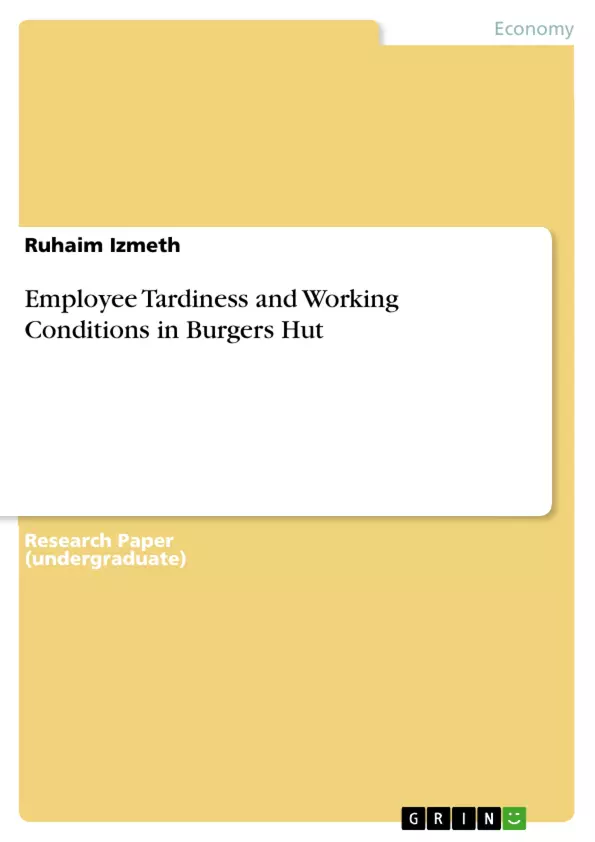This case study investigated the work-environment related reasons behind employee tardiness in a recently established fast food joint, ‘Burger’s Hut’. It was found, after observation sessions and interviews that late night work shifts and non-flexible leave scheduling were the main reasons for the problem. It is recommended that the Burger’s Hut develops a strict policy to prevent tardy employees before the problem lead to other withdrawal behaviors like absenteeism and turnover.
Inhaltsverzeichnis (Table of Contents)
- Introduction / Rationale
- Problem statement
- Objectives
- Literature Review
- Evolution of Human Food Consumption
- The boom of the Fast Food Industry
- Labour sourcing in the Fast Food industry
- Challenges faced by Fast Food employees
- Employee Tardiness
- Effects of Tardiness
- Factors affecting Tardiness
Zielsetzung und Themenschwerpunkte (Objectives and Key Themes)
This research aims to investigate the relationship between working conditions at Burger's Hut and employee tardiness. It seeks to identify specific work conditions contributing to the problem and provide recommendations for improvement. The study is limited in scope, focusing solely on a single fast-food outlet, and thus generalizability to other settings is limited.
- The impact of working conditions on employee tardiness.
- Specific work-related factors contributing to tardiness at Burger's Hut.
- The relationship between tardiness and other withdrawal behaviors (absenteeism, turnover).
- Recommendations for Burger's Hut to mitigate employee tardiness.
- The challenges faced by employees in the fast-food industry.
Zusammenfassung der Kapitel (Chapter Summaries)
Introduction / Rationale: This section introduces Burger's Hut, a small fast-food restaurant experiencing issues with employee tardiness. It explains that the research focuses on identifying work-related causes of tardiness and aims to offer solutions to the management. The study's limitations, focusing on a single organization, are also acknowledged. The introduction highlights the problem’s impact on customer satisfaction and revenue, setting the stage for the investigation.
Literature Review: This chapter provides a broad overview of the fast-food industry, its growth, and the challenges faced by its employees. It traces the evolution of food consumption, highlighting the rise of fast food and its impact globally. The chapter delves into labor sourcing practices, emphasizing the use of low-skilled labor, high turnover rates, and the resulting challenges for fast-food companies. It then discusses common employee grievances, such as unpredictable schedules, late-night shifts, and unfair scheduling practices. The review also explores the existing literature on employee tardiness, its effects, and various factors that contribute to it, setting the context for the case study's investigation of tardiness at Burger's Hut. Themes of worker exploitation, the pressures of the fast-food industry and existing research into employee tardiness are presented.
Problem statement: This concisely states the central research question: Which working conditions at Burger's Hut affect the tardiness of its employees? This sets the research objective.
Objectives: The objectives clearly outline the research goals: to identify factors affecting employee tardiness generally; to determine the specific working conditions at Burger's Hut that contribute to tardiness; and to provide recommendations to Burger's Hut management on how to address the problem. These objectives direct the research approach.
Schlüsselwörter (Keywords)
Employee tardiness, working conditions, fast food industry, employee turnover, absenteeism, late-night shifts, flexible scheduling, work-life balance, employee satisfaction, fast food restaurant, case study.
Frequently Asked Questions: Analysis of Employee Tardiness at Burger's Hut
What is the main topic of this research?
This research investigates the relationship between working conditions at Burger's Hut, a fast-food restaurant, and employee tardiness. It aims to identify specific work conditions contributing to tardiness and provide recommendations for improvement.
What are the key objectives of the study?
The study's objectives are threefold: 1) To identify factors affecting employee tardiness generally; 2) To determine the specific working conditions at Burger's Hut that contribute to tardiness; and 3) To provide recommendations to Burger's Hut management on how to address the problem.
What are the key themes explored in the research?
Key themes include the impact of working conditions on employee tardiness, specific work-related factors contributing to tardiness at Burger's Hut, the relationship between tardiness and other withdrawal behaviors (absenteeism, turnover), and recommendations for Burger's Hut to mitigate employee tardiness. The challenges faced by employees in the fast-food industry are also explored.
What is included in the literature review?
The literature review provides a broad overview of the fast-food industry, its growth, and the challenges faced by its employees. It examines the evolution of food consumption, the rise of fast food, labor sourcing practices, common employee grievances (unpredictable schedules, late-night shifts, unfair scheduling), and existing research on employee tardiness, its effects, and contributing factors.
What is the scope of the study and its limitations?
The study is limited in scope, focusing solely on a single fast-food outlet (Burger's Hut). Therefore, the generalizability of findings to other settings is limited.
What is the problem statement?
The central research question is: Which working conditions at Burger's Hut affect the tardiness of its employees?
What are the chapter summaries?
The document provides summaries for the Introduction/Rationale, Literature Review, Problem Statement, and Objectives chapters. The Introduction sets the context, the Literature Review provides background information, the Problem Statement defines the central research question, and the Objectives outline the research goals.
What are the keywords associated with this research?
Keywords include Employee tardiness, working conditions, fast food industry, employee turnover, absenteeism, late-night shifts, flexible scheduling, work-life balance, employee satisfaction, fast food restaurant, and case study.
What is the structure of the document?
The document provides a comprehensive language preview including the title, table of contents, objectives and key themes, chapter summaries, and keywords.
- Citation du texte
- Ruhaim Izmeth (Auteur), 2013, Employee Tardiness and Working Conditions in Burgers Hut, Munich, GRIN Verlag, https://www.grin.com/document/285101



